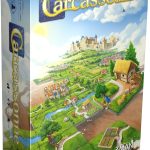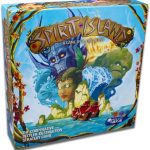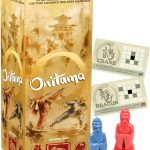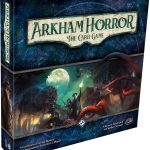Make It Yours – See Your Price On Amazon!
Your Sales Price $22.79 - $19.99
A quick rundown of this product’s key features:
DARING EXPLORERS: Embark on a thrilling adventure as daring explorers in Small Islands, a tile-placement game set in a magnificent archipelago. Uncover the secrets of ancient temples and exploit the islands’ abundant resources to bring wealth and prestige to your clan.
STRATEGIC TILE PLACEMENT: Plan your moves carefully as you draw and place Landscape Tiles to expand the archipelago. Choose from a variety of available tiles, including Ship Tiles, to create a thriving island network.
OBJECTIVES FOR SUCCESS: At the start of each round, secretly select an Objective Card from three options. Strategize and adapt your gameplay to achieve your objectives and earn Prestige Points, leading you closer to victory.
ADVANCED MODE: Challenge yourself with the Advanced Mode, offering a wide array of Objective Card combinations. Create unique goals and customize your play experience for endless replayability.Solo Mode, innovative for its mechanics as well as for the very concept of a solo mode in a tile-placement game.
SOLO MODE WITH AI: Experience an innovative Solo Mode, featuring an AI opponent with distinct personalities and behaviors. Engage in a captivating solo gaming experience that adds depth and excitement to a tile-placement game.
Our Top Reviews
Reviewer: J M
Rating: 5.0 out of 5 stars
Title: Small Islands, a tile-placement game for 1-4 players played in about 30 minutes.
Review: For what this game is, it’s actually quite good. Maybe a little bit intimidating at first, but it’s pretty straightforward once you get to sailing around on placed tiles and establishing your villages. It’s split into three games really. A solo mode (think solitaire) with a set of designer cards used to simulate artificial intelligence or a “cpu player”; a basic mode for 2-4 players intended for a very casual game of islands exploration and simple resources collecting; and an advanced mode for 2-4 players intended to be more challenging in terms of collecting resources on the various islands and challenges pertaining to which islands get villages. Games are pretty short overall, at about 30-40 minutes or so. And given that you have tile-placement used to build the world, there’s a pretty high replayability. Overall, I can recommend this game to anyone wanting something lightweight to mid-level gaming intensity.
Reviewer: Poiuytrew.q
Rating: 5.0 out of 5 stars
Title: Solo review and comparison with similar games
Review: I played this game only with the solo mode. If you have played other board games with a small deck of cards to facilitate a “bot”, then this game will be easy to learn in solo mode.Quick explanation of gameplay: Each player drafts one of three face up tiles featuring water and land and adds it to a communal map of tiles. Players have their own secret bonus cards which change every round with goals they are trying to achieve based on features on the islan, which is some combination of temples, orange fruit, green leaf, or pink flower, or anchors/ports. The round ends when a player drafts a ship tile and adds it to the map. This is repeated until the last shift is placed or island tiles run out.Things I like: I like the bright artwork and colors. I learned from the rulebook and the game was easy for me to learn and play right away. The rulebook has clear instructions for basic play and highlights differences for the advanced play. The only difference with advanced play is that you get to “design” your bonus card instead of the pregenerated one, so the game essentially comes with many different combinations for the secret bonus card. The rulebook has some “quests” it wants the player to achieve before attempting advanced play, but you can play with the “advanced” cards after 1-2 plays.Iconography: It is mostly clear – I misunderstood a few of them in my first few plays – but the rulebook does offer clarifications for the different bonus cards. There isn’t a “key” and you m ostly have to find the exact card or look for an example. I think ONE of the icons is not clear. One of the bonus cards has an arrow pointing downard to indicate the “lowest” resource which is fine. However, an upward arrow doesn’t not mean the highest resource. For bonus cards with the upward arrow, you would always pick the highest resource anyway, but for some reason the explanation for the card does not match as if there was editing/modification in production but part of the rules was not changed to reflect the change during design.I do not like that the point tokens are not double sided – you have to flip them over to find the right value. Having a generic back side for different valued “coins” serves no purpose. Also, some of the tokens are very small, but since there are only 4 of them and they are small to match the size of the icons on the tiles, they do not bother me as much.Things I like about the game: I like that at the beginning of a round, each player has 3 bonus cards – they must discard one, keep one for the current round, and bank another that could be used in a future round. The banked card allows a player to have some forward planning or strategies, especially if none of the tiles are beneficial at the moment for the current bonus card.I like that the round end can be triggered by players. After 6 tiles have been drafted, anyone can place a ship tile which ends the round immediately.I like that the game has a solo mode which is easy to implement and has 6 levels of difficulty. The solo bot isn’t very smart though, so it can be easy to beat, until the hardest level.I expect that as player count increases, the game becomes more random. I would be interested to play this game multiplayer someday, but I don’t think it is a game that we would keep long term. However, if you are looking for a tile-placement game that is visually appealing, easy to learn, and has a solo and multiplayer mode, then this might be one to consider.Other games that I’ve played with a similar theme include Land Vs Sea and Oceania by Klaus Treuber (Catan). Land Vs Sea I think is a little more convoluted in terms of rules and scoring and only plays 2-3 players. However, it has interesting artwork on the tiles like hidden Easter eggs. Oceania actually is the most thematic of the three, because I get the feeling of exploring an archipelago and Moana songs pop in my head, but it only plays 1-2 and while its artwork is functional, it isn’t vibrant or modern looking. Small Islands has the most pieces and the largest box.In comparison:Thematic mechanism: OceaniaArt: Land Vs. SeaSolo mode: Small IslandsPlayer count: Small IslandsPortability: Land Vs. SeaOther games that are often cited as being similar include Carcassonne and Isle of Sky – both of which I’ve played once and both did not interest me.Hopefully this review has been helpful and interesting!
Price effective as of Mar 21, 2025 15:06:33 UTC
As an Amazon Associate Dealors may receive a commission for purchases made through these links.









